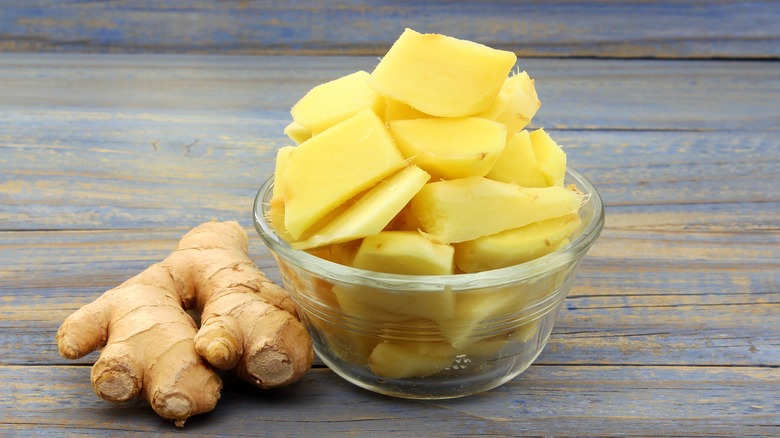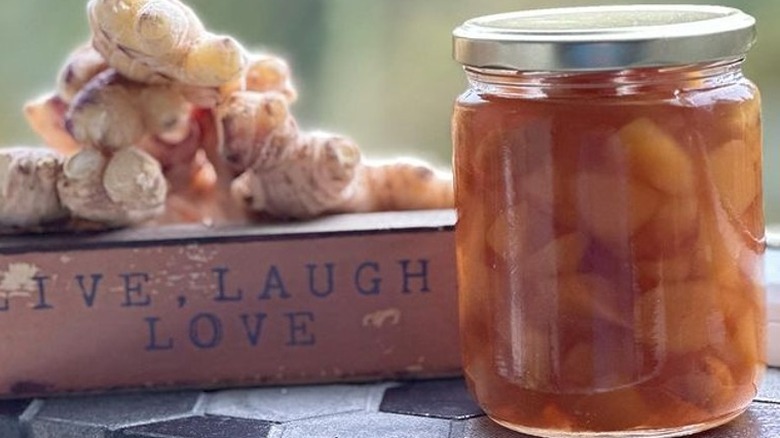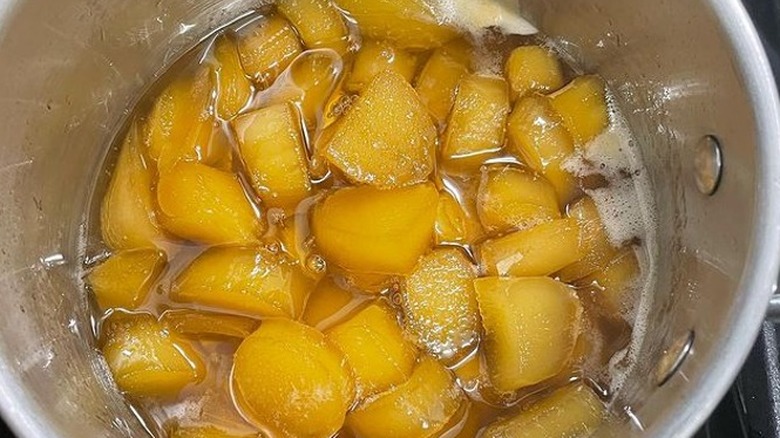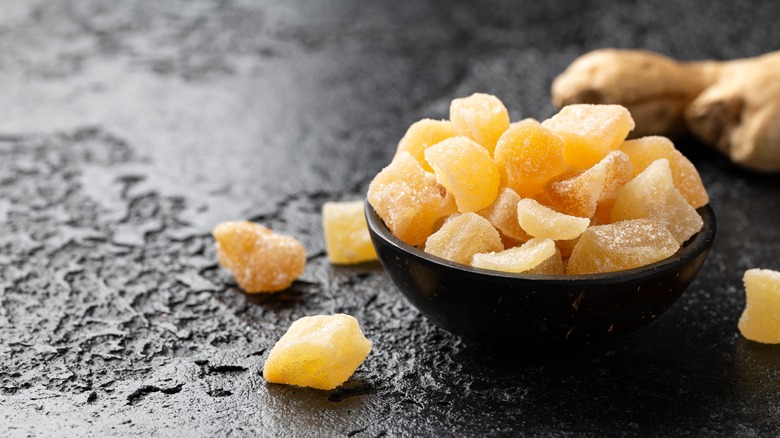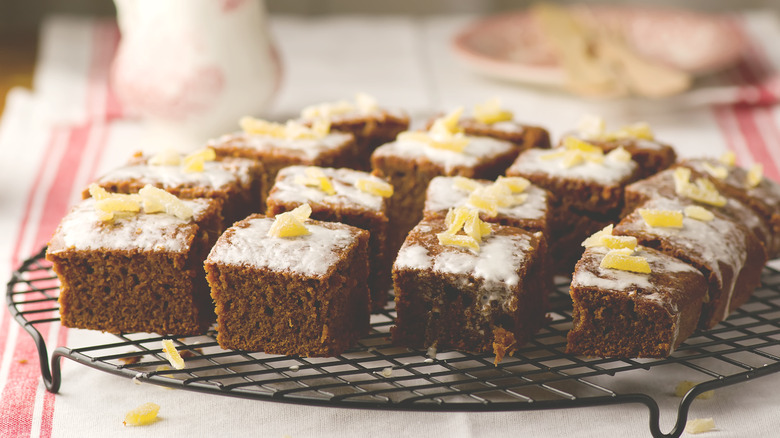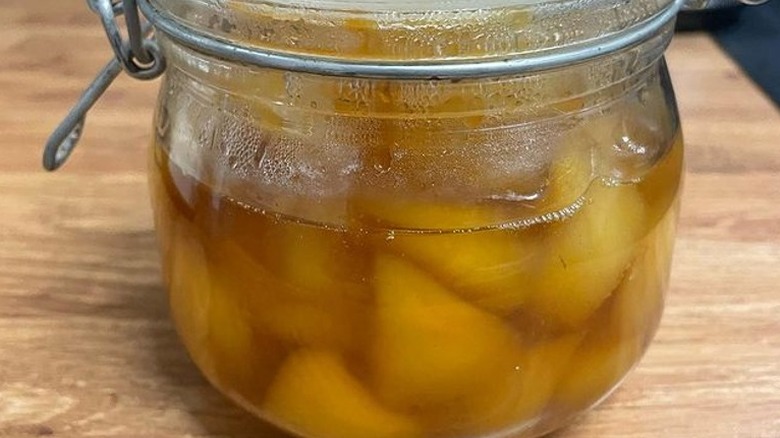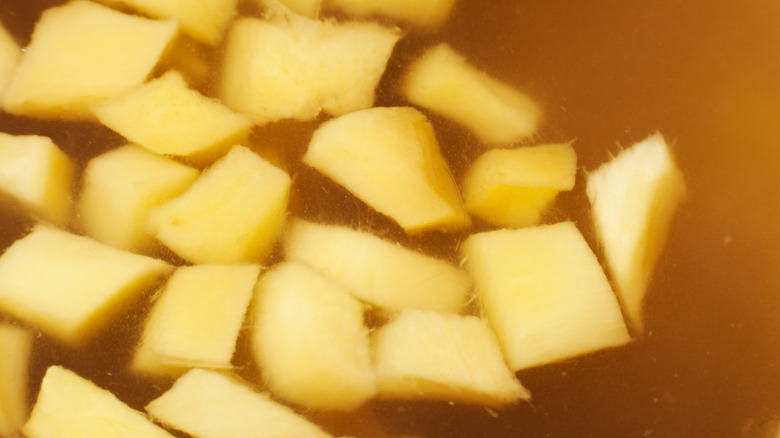Stem Ginger, The Sweet Pantry Treat For Your Cocktails & Baked Goods
Ginger makes appearances in a range of different British desserts, from cookies (biscuits) to cakes and puddings. But to flavor these pastries, British chefs don't rely on fresh or candied ginger to supplement the flavors of ground ginger. Instead, they look to stem ginger: young ginger roots that have been cooked and preserved in a flavorful, sugary syrup.
Every bit that goes into a bottle of stem ginger can be cooked with, from the root itself to the liquid that pieces of the aromatic are submerged in. Not only can stem ginger be eaten on its own or added to a host of pies and pastries, but it can also be used to liven up savory dishes. And when you've used up all the stem ginger, the sweet ginger syrup can be used to make ginger ale, specialty cocktails, as a sweetener for hot drinks like tea, or as an ingredient for marinades and salad dressings.
What does stem ginger taste like?
As you'll know well if you've ever had it, fresh ginger is packed with plenty of flavor. Its taste is often described as spicy or peppery, thanks to the presence of a plant compound known as gingerol. Its aroma is quite fresh and even reminiscent of lemons. And while stem ginger has the same basic flavor profile as fresh ginger, its taste and scent are more mellow, thanks to the time it's spent poaching in both water and sugary syrup.
But the ingredient isn't so mellow that it isn't able to shine when added to treats like sticky gingerbread pudding, which leans into stem ginger to give it its warming flavor. The ingredient also brings its heat to ginger sponge puddings, where stem ginger is used for the pudding itself and the syrup it's kept in can be used in the sauce, giving the dessert an extra, heavenly bite.
How is stem ginger made?
While commercially made stem ginger is available for purchase, it can be made at home too. To make this decidedly British ingredient, first make sure that you're working with young ginger by ensuring that the skin of the rhizome is unblemished, easy to peel off, and that the ingredient is firm to the touch. You'll then want to freeze the ginger overnight to make it easier to peel and to help it cook faster.
When you're ready to cook, peel the ginger with the help of a spoon and then cut it into chunks about an inch long. Then poach them by placing them in a pan and adding enough water to cover them. First, boil the ginger and water, then reduce the heat and simmer for an hour or two. The ginger should be tender after that time.
Remove the ginger but save the cooking water, which you'll need to make a simple sugar syrup. Once the syrup is thick enough, you'll want to put the cooked ginger back into the syrup to cook for a bit longer. Your stem ginger can then be stored in pre-sterilized jars.
Stem ginger vs. crystallized ginger
Stem ginger isn't the only type of sweetened ginger available, as there's also crystallized ginger — an ingredient that can be found on both sides of the Atlantic. The difference between the two comes down to the way they're made. Crystallized ginger is stem ginger that has been further poached until the root itself becomes translucent. The cooked ginger is then taken out of its liquid and air-dried before being rolled in granulated sugar.
When ginger is crystallized in this way, it can be enjoyed on its own, or you can cut it into smaller pieces and use it to make cookies and other treats. Crystallized ginger can even be mixed in with nuts and spices, then used in fruit fillings made with apple or pear for extra heat. Additionally, it can be dipped in chocolate and served as a sweet by itself. Some cooks have even been known to use crystallized ginger to cook carrots.
How to cook with stem ginger
Stem ginger is the go-to addition when you're making desserts with a hot, spicy bite. When you use the ingredient to flavor puddings, stem ginger can be blitzed in a food processor and chopped up into tiny pieces, which are easily amalgamated into a batter. When it's pureed, stem ginger can even be added to a smooth, silky dessert like chocolate mousse. When used in ginger cake, ginger snaps, or as a topping for apple pie, the ingredient can be easily chopped to the size you require and then mixed in.
Because stem ginger is a culinary gift that keeps on giving, you can also cook with its syrup, which can be used as a base to make ginger ale or as a flavor booster for popular cocktails like Moscow mules, lemon drops, and whiskey sours. It might give exactly the extra kick you're looking for.
Nutritional information about stem ginger
Ginger itself doesn't have much in the way of calories, vitamins, or minerals, but it's prized for its healing properties, thanks to the presence of gingerol. Fresh ginger is a known balm against nausea and stomach upsets, and there are studies that indicate it can be used as an anti-inflammatory as well. Unfortunately, the same cannot always be said of stem or crystallized ginger, because both need to be poached for long periods of time, and studies have shown that boiling ginger at higher temperatures can have a negative impact on the root's purported medicinal properties.
While ginger syrup often has plenty of sugar, the syrup may actually still be used to help deal with digestive problems or as a cure for nausea, depending on how it's made. It can even help relieve the symptoms of a cold at times, including sore throats and congestion.
How to store stem ginger
While many British home cooks prefer to make stem ginger themselves, the ingredient is easy to buy online in America. Once made or acquired, stem ginger is a fairly robust ingredient. If the jar remains unopened and is kept in a cool, dark place, it can keep for up to 12 months. But once opened, a jar of stem ginger is best kept in the fridge and consumed within two months, according to Tales From The Kitchen Shed.
If you've consumed all the stem ginger and only have syrup left to contend with, the liquid can be frozen and kept for up to two months before being used. Otherwise, the syrup needs to be kept in a sealed, refrigerated container and used within two weeks, according to The Kitchn.
